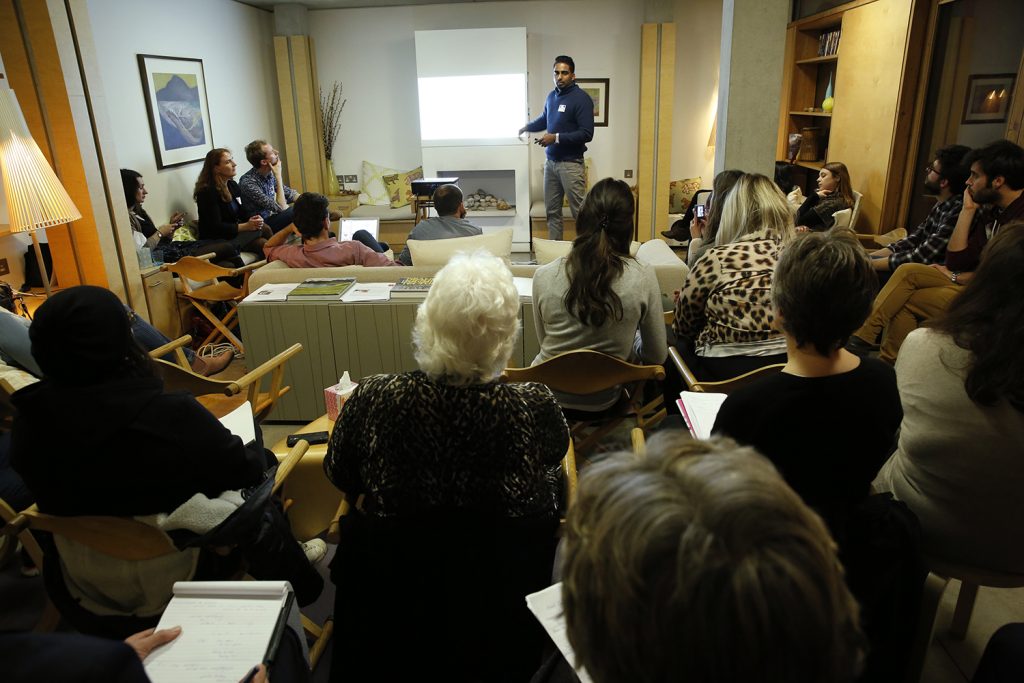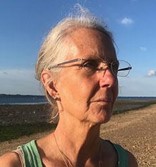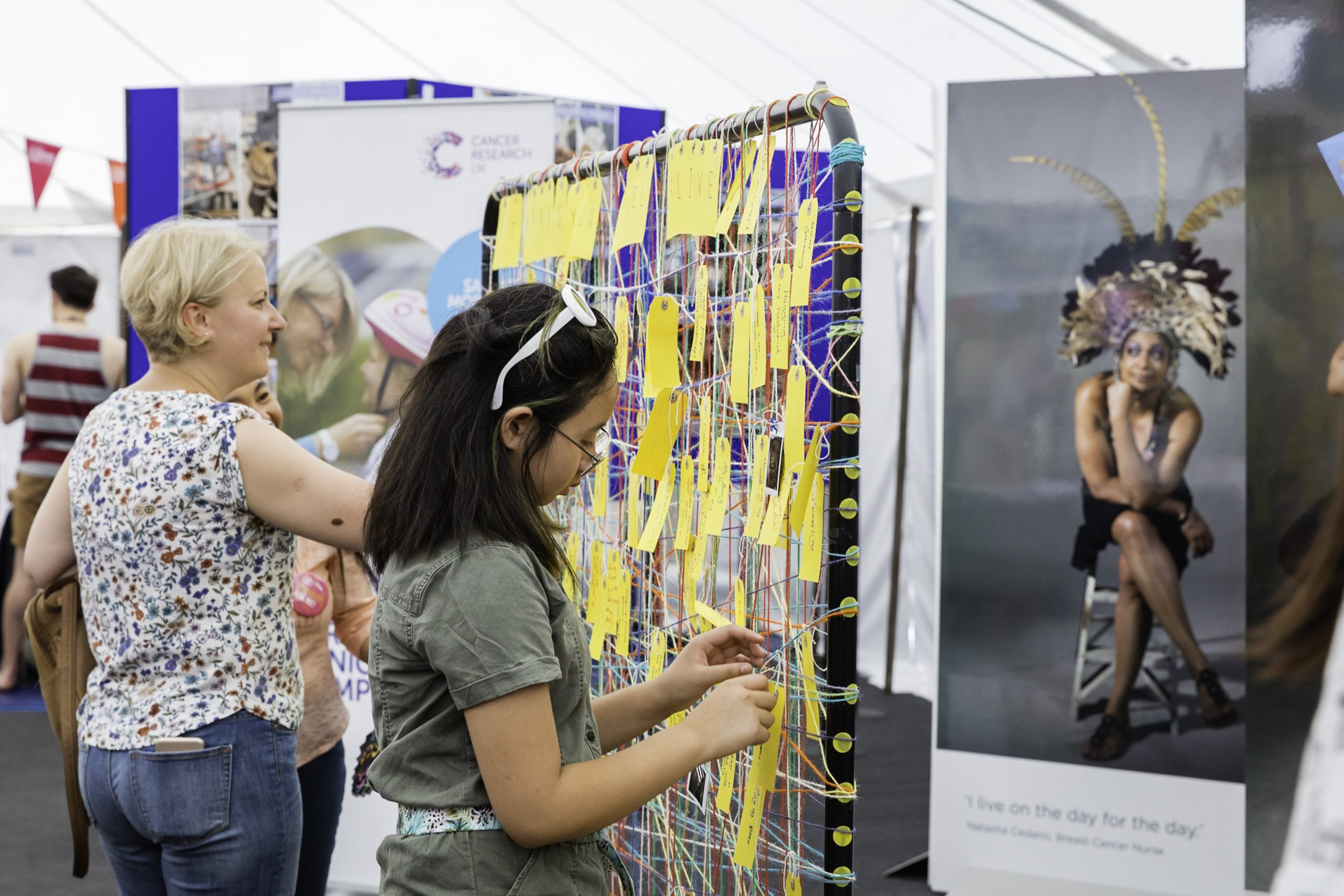CRUK Senior Research Nurse, Kelly Gleason, shares how one patient’s vision continues to inspire her, and influence how we involve and engage the public in healthcare and research design at Imperial.
Sunday evening, November 14th 2014, we stood in the dark on Exhibition Road, staring through the large glass windows into the main entrance of Imperial College London. There stood twenty-four portraits, assembled as six pillars, ready to tell their story. A woman in a black dress sitting on an aluminium step stool wearing a carnival headdress, a man in leathers on a motorcycle, a toddler in her dad’s arms gesturing a story with her hands, these were the people keeping Rina Dave alive. These were the people she met during her treatment for stage 4 breast cancer; the people Rina wanted the world to see at their most alive. She also wanted to show how many people were keeping her, Rina, alive.
As a patient at Charing Cross Hospital, Rina had the idea to photograph the people involved in her care. She wanted to portray them outside their healthcare roles to humanise them in the eyes of other patients.
In 2015, Rina peacefully passed away at home in India. Rina taught me many things during the hours we worked together, and I wanted to share these insights with others. Professor Sophie Day of the Patient Experience Research Centre helped me to explore how we could continue to share Rina’s project.
In 2019, inspired by Rina’s photography project, we designed a feedback wall to engage and involve members of the public in research at Imperial’s annual Great Exhibition Road Festival. We were working on a research project, funded by the Wellcome Trust, called ‘People Like You’: Contemporary Figures of Personalisation. One aspect explored personalised medicine and health care in breast cancer medicine at Imperial College Healthcare Trust. We used Rina’s question, “What makes you feel alive” to start a conversation about what it was that inspired each individual person. This in turn allowed us to continue the conversation and share some of our research around personalised medicine and cancer care at different Trust sites.
The feedback wall was an easy way to begin a conversation: people stopped to read the tags, we introduced the question for feedback and invited them to leave their thoughts. People thought with family members or friends, and children enjoyed taking part. People wrote their answers on tags and tied them to the wall. Feedback was left anonymously and the more answers we collected, the more people stopped to read and then take part.
The success of the feedback wall at the 2019 festival prompted us to test it in other settings.
At a public involvement training session for cancer researchers, we used a feedback wall to ask researchers a question before and after training. At the beginning of the session we asked, “What do you find most challenging about involving patients in your research?”. This gave us valuable information on how to support researchers during training – researchers working in labs wanted us to facilitate access to patients. At the end of the training we asked them, “What do you now look forward to when involving patients in your research?”.
Later that year, at an Imperial National Institute of Health Research Biomedical Research Centre (NIHR BRC) Open Day, we showcased the Imperial Science Café platform, which had been running for almost a decade at Maggie’s West London. Researchers presented findings to patients and the public to open a dialogue around research and cancer care. We asked visitors what research topics they most wanted to hear about and used some of their ideas to shape the upcoming Imperial Science Café series and others to share with researchers across the BRC.

We also wanted to test the feedback wall in a clinical area. After discussion with some of the nurses in oncology services at Charing Cross Hospital we decided to test it out in the Chemotherapy Day Unit. The nurses were keen that the wall facilitate conversations that might help them learn something about their patients rather than a more traditional response to services. As everyone goes home each day from the Chemotherapy Day Unit, we decide to ask both patients and staff, “What do you most look forward to when you go home at the end of the day?”. Unfortunately, due to COVID-19, this feedback wall had to be removed shortly after installation, but it was popular while in use and we hope to put it back soon.
Valuable information was gained from these feedback wall ‘test’ sites. It proved to be an easy, inexpensive and engaging tool. And so, we made this video…
Personally, I appreciated the aesthetic of the piece and the ability it gave, with the right question, to begin conversations with individuals who could also interact anonymously if they preferred. People seemed to enjoy the manual aspects of taking their tag, writing their thoughts and tying their tag to the wall. Some people walked away to think about the question and returned to eventually add a comment.
I also appreciated the versatility of the feedback wall, it could be built small or large, using different materials to suit the environment which might involve infection control guidance in hospitals, differently sized areas, different amounts of time for display etc.
The more I used the wall, the more I could see different possibilities in a variety of areas for a range of purposes. I would like to use the wall to explore why research works in some rather than other clinical areas. I would like to see if a wall left in situ for a period of time would attract comments from staff about problems that arise which we could then address. What issues can a feedback wall highlight that other methods do not?
Rina’s question was, what makes you feel alive? She wanted to know the things in life that matter most to people. Her images were beautiful and powerful, and her message was clear: the many people involved in caring for her – doctors, nurses and other healthcare professionals – were also unique individuals. Sharing what matters to us within the roles we play helps connect us to our shared humanity.
Rina had many ideas for projects that sadly she was unable to begin. She wanted people to understand the variety of experiences with cancer and to know that every cancer patient, regardless of their diagnosis and the stage of their disease, had something important to say and something of value to share.
Years on, Rina’s project continues to influence and inspire me in my work in cancer research.
In memory of our friend who reminded us above all to appreciate life.
Authored by Kelly Gleason, with Sophie Day
 Kelly Gleason
Kelly Gleason
Kelly is the CRUK Senior Research Nurse at Imperial College London. She manages the translational research team working in our hospitals, provides education and training for the research delivery teams, and coordinates the Patient and Public Involvement Group and activities.
If you would like further information about Kelly’s work or the feedback wall, please email k.gleason@imperial.ac.uk.
 Sophie Day
Sophie Day
Sophie is a Professor of Anthropology at Goldsmiths, University of London and a Visiting Professor at Imperial College London where she established our Patient Experience Research Centre with Helen Ward in 2011. She has been working on personalised breast cancer medicine as co-principal investigator in ‘People Like You’: Contemporary Figures of Personalisation, a project in the medical humanities supported by the Wellcome Trust (2018-2022, grant 205456/Z/16/Z).

